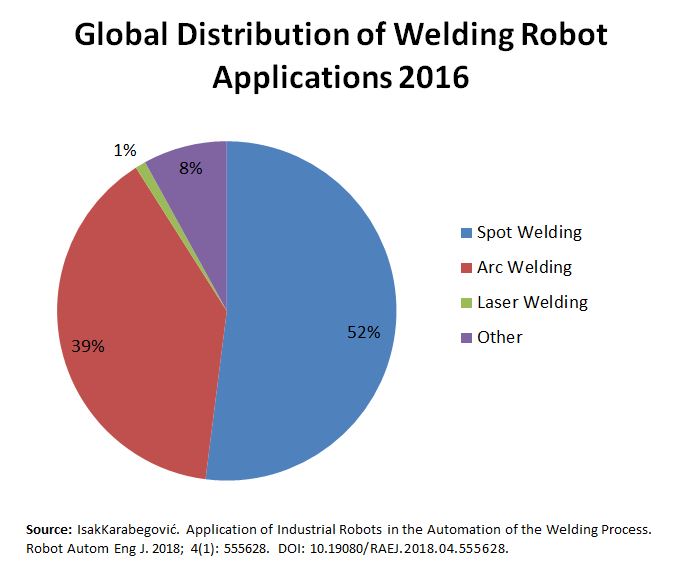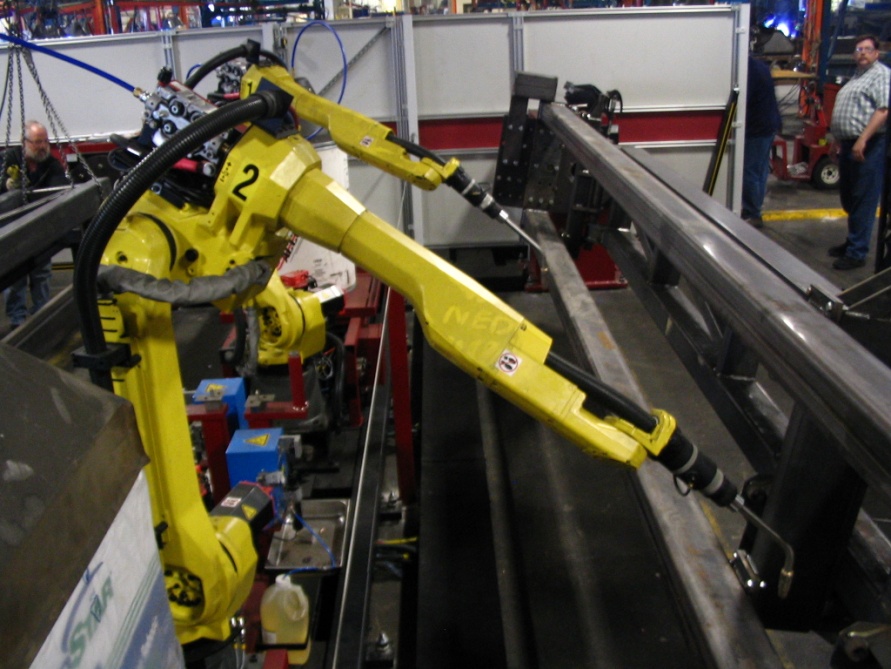Used on production lines for decades, robotic welding is a tried and tested technology that can reduce costs without compromising quality. Despite the advantages, many businesses believe that robotic welding systems are expensive and only used in sprawling automobile factories.
In reality, technological advances now make automated systems affordable for small and medium enterprises and supplement traditional fabrication techniques perfectly. Automated Welding using Industrial Robots can benefit manufacturers of any size, making production lines more efficient and resilient to workforce highs and lows.
What is Robotic Welding?
The US automobile industry embraced robotic welding in the 1960s, and the technology soon spread to other industries. Between 2010 and 2013, companies installed over 150,000 industrial welding robots, and the market for welding automation is predicted to grow at a compound annual growth rate (CAGR) of 8.91% between 2018 and 2023. With many vendors exploring new technologies, robotic welding will continue to thrive.

Welding Robot Layout
Some robot arc welders consist of a mechanical unit that can manipulate the welding gun and work on a static part, while others move the part and weld with a static gun. A command unit using pre-programmed commands directs the robot’s actions, sometimes using sensors to provide machine vision and extra precision. Robotic welding is a very versatile solution for sheet metal or complex components.
Robotic welding units can use a number of welding techniques:
- Arc welding
- Gas welding (MIG/GMAW and TIG/GTAW)
- Laser welding
- Resistance spot welding
- Plasma welding
Alongside the welding apparatus, robots often include ancillary equipment such as a wire cutter, nozzle cleaner, and torch changer. Components enter the cell/work area and the robot completes the weld before the component moves to the next stage.
Movement
Robotic welding systems move in the three x, y, and z-axes using a rotational wrist. Articulated robots incorporate a lower arm and wrist providing three axes of movement each, allowing the welding torch to move in three dimensions.
A number of robots include manipulators that extend the range for working on large pieces and complex geometries, often aided by the additional of a seventh axis at the base. Synchronised control of the welding torch and manipulator maximises speed and accuracy.
Sensors
Some welding robots contain sensing technology and artificial intelligence, which measure the process and send data to the control system, offering a high degree of control. Sensors can ensure a number of parameters remain within acceptable limits, including:
- Voltage
- Current
- Wire feed
- Location and geometry of the work piece and weld
- Seam finders to monitor quality
- Collision sensing
- Video equipment to verify part position and clamping
Although robots require significant investment, the advantages make robotic welding worthwhile across a number of industries.

Advantages of Robotic Welding
Many small and medium enterprises perceive that robotic systems are expensive and difficult to use, but the latest technologies are affordable and simple to program and maintain. At a time when customers are increasingly price sensitive, yet demand higher quality and consistency, manufacturers must improve efficiency without affecting quality.
The main advantages of robotic welding include:
- Flexibility
- Increased Efficiency
- Quality
- Lower Costs
Flexibility
Modern welding robots are can perform single repetitive tasks or complete different tasks, even over the course of a single shift, by drawing upon a library of stored programs. This is particularly useful for businesses with smaller product runs or a large range of products.
Many robot arms support additional tools, and some hybrid processes blend automated and manual welding, especially for welds beyond the reach of humans. Custom robotic systems offer optimal configuration to maximise the use of space, while modular systems allow plants to adapt systems to match their unique needs.
Increased Efficiency
Whilst any individual weld takes the same amount of time regardless of whether it is a human or a robot, automated welders work at a greater efficiency than humans. By some accounts, robotic welders can achieve up to 85% efficiency, compared to around 20% for most welding professionals.
The predictable cycle time makes scheduling easier and removes potential bottlenecks; giving a consistent throughput and helping manufacturers deliver components on time. Because robots weld cleanly and with high precision, there is less need for post-weld cleanup and dressing, saving time further down the production line.
Quality
Because weld speed, current, and other variables remain constant, robots deliver very high weld quality. For example, gas metal arc welding (GMAW) requires a very stable arc length and speed, alongside consistent torch angle and position. Welding robots offer tenths of a millimetre precision at a constant speed, often supported by vision systems that provide quality control.
Automated systems offer:
- High output
- High quality and repeatability
- High precision
- Weld accuracy
- Identical parts
Robots do not suffer fatigue or distraction, so weld quality is consistent and the lack of compromised welds supports customers with stringent quality requirements for critical systems.
Costs
Robotic welding can lower costs and deliver a return on investment in a number of ways. A robot’s ability to position parts with high precision and use automated parameters creates fewer errors that require rework or outright rejection. Robots waste less gas, base metal, electricity, flux, and other consumables, which creates significant savings over time and ensures that work is less likely to stray over budget.
In addition, robots are tireless and can operate 24/7, and can lower labour costs significantly. Businesses will spend less on training programmes, suffer fewer occupational injuries, and can overcome any shortages in skilled labour. Instead of repurposed general robots, some vendors now provide specialised welding units that are less bulky and lower-priced, making the technology even more affordable for smaller businesses.
Programming and Communications
Welding robots are very complex machines but can be easily programmed by a Robotic Automation Specialist, with little ongoing support required. In contrast, welding takes years to learn, leading to skills shortages and the need for higher wages to attract staff.
A robotic process line can store many preset programs, allowing the same production line to store multiple programs for different products, requiring only a relatively simple change of tools on the robot’s arm. This flexibility makes robotic systems perfect for one-off orders and lower volume producers. Robotic welding systems take advantage of modern communications networks that transmit high volumes of information for analysis and allow centralised control in near real time.
Despite the advantages, robotic welding systems can’t replace all manual welding tasks because some components are too difficult for a robot to manipulate or access. Experienced welders can start a job straightaway, adapt to changes, and provide instant quality control. Robots usually take over repetitive tasks and free up skilled welders to concentrate on complex jobs.
Get expert support from our robotic welding specialists
While robotic systems are still a significant investment, the price has fallen sharply and the capabilities and flexibility of modern operating software makes welding robots a smart purchase for many Australian businesses. Robotic welding offers precision, quality, and consistency, while the reduced costs mean the technology increasingly makes business sense.
At Robycs Technology, our expertise will help you find the perfect automated welding system for your business, drawing upon expertise in ABB, KUKA, Universal Robots, FANUC, Mitsubishi and many other vendors.
We don’t just help you choose the right robots: we work with you from the start and help you identify where automated welding will streamline production and help you reduce costs. If you want to take advantage of robotic welding, contact us.

